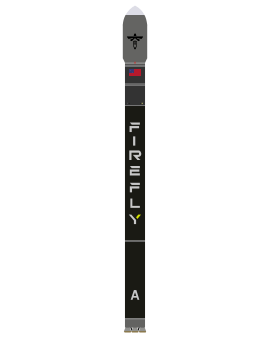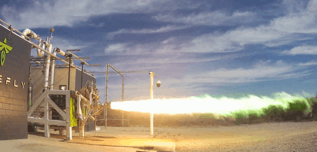Firefly Alpha
 | |
| Function | Smallsat Launch Vehicle |
|---|---|
| Manufacturer | Firefly Aerospace |
| Country of origin | United States |
| Cost per launch | $15 million |
| Size | |
| Height | 29 m |
| Diameter | 1.82 m |
| Mass | 54,000 kg |
| Stages | 2 |
| Capacity | |
| Payload to LEO | 1000 kg [1] |
| Payload to SSO | 600 kg |
| Launch history | |
| Status | In Development |
| Launch sites | Vandenberg Air Force Base SLC-2W[2][3] |
| First stage | |
| Diameter | 1.82 m (6 ft 0 in) |
| Engines | 4 X Reaver 1 |
| Thrust | 736.1 kN (165,500 lbf) |
| Specific impulse | 295.6 seconds (2.899 km/s) |
| Fuel | RP-1 / LOX |
| Second stage | |
| Diameter | 1.82 m (6 ft 0 in) |
| Engines | 1 X Lightning 1 |
| Thrust | 70.1 kN (15,800 lbf) |
| Specific impulse | 322.0 seconds (3.158 km/s) |
| Fuel | RP-1 / LOX |
Firefly Alpha (Firefly α) is two-stage orbital expendable launch vehicle developed by the American aerospace company Firefly Aerospace to cover the commercial small satellite launch market. Alpha is intended to provide launch options for both full vehicle and ride share customers. [1]
Design

Alpha was initially designed with a first stage powered by an FRE-2 engine, which consisted of twelve nozzles arranged in an aerospike configuration.[4][5] The engine used methane, as opposed to RP-1. The second stage was to be propelled by the FRE-1 engine, which used a conventional bell nozzle. It was intended to launch 400 kg to Low Earth Orbit.[6][7]
After Firefly's corporate reorganization, Alpha was redesigned. The vehicle now uses two stages, both 1.8 m in diameter, filled with RP-1/LOX propellant. The main body of the rocket is constructed using a lightweight carbon composite material.[3]
Alpha's first stage is powered by four Reaver 1 LOX/RP-1 engines, delivering 736.1 kN (165,500 lbf) of thrust. The second stage is powered by one Lightning 1 LOX/RP-1 engines, delivering 70.1 kN (15,800 lbf) of thrust. Lightning 1 was test-run for nearly 5 minutes on March 15, 2018 during a long duration test fire. The engine was fired at Firefly's Test Stand 1 in Briggs, Texas. [8][9]
The Alpha airframe uses all carbon-fiber composite material in its construction. Use of denser materials like titanium and aluminum results in a heavier airframe which requires more fuel to launch, making the carbon-fiber body more fuel efficient. [8]
In March 2018, Firefly said that the development of Alpha was expected to cost approximately $100 million. [8] The company is also in development of a future rocket, Firefly Beta, which will consist of three Alpha cores strapped together. [2]
Intended usage
Alpha is designed to launch a 1,000 kg payload to a 200 km Low Earth orbit, or a 600 kg payload to a 500 km Sun-synchronous orbit, suitable for CubeSats and other small payloads. Primary payloads can be integrated by themselves or with a Secondary payload, with capacity for up to 6 CubeSats.[1][3] This allows Firefly's customers to have a dedicated small-satellite launcher, reducing the issues of ride-sharing payloads and secondary payloads. These smaller satellites can have an orbit that is not determined by a larger payload and can launch on their own schedule instead of waiting on the readiness of all other payloads.
In 2015 NASA's Launch Services Program awarded Firefly Aerospace a $5.5 million Venture Class Launch Services contract to develop Alpha to enable easier access to the small satellite market. [10][11]
Firefly Aerospace plans to use a Horizontal Integration Facility (HIF) to integrate payloads.[3]
Alpha is also intended to be a direct American competitor in the small satellite market to India's PSLV, as they believe its ride-share capability in the market threatens US domestic launchers. [12]
Launch sites
As of 2018 Firefly Aerospace plans to use Vandenberg Air Force Base SLC-2W to support the launches of both Alpha and future launches of Beta, which formerly launched Delta and Thor-Agena rockets, and currently launches Delta II rockets.[2] Additionally they are also looking into operating at Kennedy Space Center, Cape Canaveral Air Force Station or the Mid-Atlantic Regional Spaceport (MARS).
The first launch of Alpha is scheduled for the third quarter of 2019, and Firefly aims to have production capacity to support the launch of two Alpha vehicles per month by the first quarter of 2021. [13][3]
Planned launches
| Date / time (UTC) | Rocket, Configuration |
Launch site | Payload | Orbit | Customer |
|---|---|---|---|---|---|
| Q3 2019 [2] | Firefly Alpha | Vandenberg SLC-2W | |||
| Maiden flight of the Firefly Alpha | |||||
References
- 1 2 3 "Firefly Alpha". Retrieved 2018-03-30.
- 1 2 3 4 Clark, Stephen (2 May 2018). "Firefly's commercial satellite launcher to use Delta 2 pad at Vandenberg". Spaceflight Now. Retrieved 3 May 2018.
- 1 2 3 4 5 "Firefly Alpha Payload User's Guide" (PDF). Retrieved 30 March 2018.
- ↑ https://www.satellitetoday.com/business/2016/09/29/firefly-alpha-rocket-combustor-completes-full-mission-duty-cycle-test/
- ↑ https://newatlas.com/firefly-alpha-aerospike-launch-vehicle/32892/
- ↑ http://space.skyrocket.de/doc_lau/firefly.htm
- ↑ http://spacenews.com/building-the-model-t-of-rockets/
- 1 2 3 Richardson, Derek (March 17, 2018). "Firefly Aerospace demos its Lightning 1 engine". Spaceflight Insider. Retrieved 4 April 2018.
- ↑ Nojas, Charmagne (March 18, 2018). "Firefly Aerospace Makes A Comeback With Lightning 1 Engine Demo In Texas". TechTimes. Retrieved 4 April 2018.
- ↑ Wistrom, Brent (October 14, 2015). "This Cedar Park Rocket Company Just Nabbed a $5.5 Million NASA Contract". AustinInno. Retrieved 31 March 2018.
- ↑ "NASA Awards Venture Class Launch Services Contracts for CubeSat Satellites". NASA.gov. NASA. Retrieved 31 March 2018.
- ↑ http://www.thespacereview.com/article/3311/1
- ↑ "Staring at Firefly Aerospace's hot rocket-engine flames in a Texas pasture". 2018-04-03.